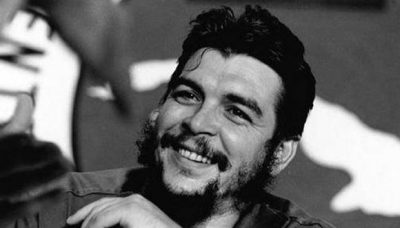Che Guevara Exhibit at the UN Human Rights Council

The home of United Nations Human Rights Council in Geneva is showcasing a poster-sized photograph of the Cuban revolutionary Che Guevara in its exhibition hallways.
In 2013, UNESCO, a branch of the U.N., included the “The Life and Works of Ernesto Che Guevara” into the Memory of the World Register. The Memory of the World Registry is engaged in preserving and protecting valuable documents and writings of human heritage from destruction.
The inventory of documents of the Documentary Collection was originally submitted by Cuba and Bolivia to the Memory of the World Register in 2013. The documents include:
“Life and Works of Ernesto Che Guevara: from the originals manuscripts of its adolescence and youth to the campaign Diary in Bolivia”, 1007 documents ― grouped in a total of 8197 pages from 1928 to 1967, concerning his revolutionary work, essays, news paper articles, biographical materials and personal works, as well as his correspondence with different persons, and his family. Of these, 431 are manuscripts by Che and 567 are documents about Che or related to him. The collection also includes valuable iconographic material by and about Che, films, letters and museum pieces.”1

Source: @HillelNeuer/Twitter
The U.S. government and its critics, conveniently forgetting its own long list of war crimes, (from Hiroshima, to the Mỹ Lai Massacre in Vietnam, the Iran-Contra Affair, the Abu Graib torture scandal, the illegal invasion of Iraq, etc., etc., etc., ad infinitum), came out against the U.N. in a brazen attempt to wipe out history that doesn’t exactly serve their purposes. David T. Killion, the United States Permanent Representative to UNESCO wrote a letter to the U.N. urging the organization to censor the exhibit.
It is ironic that the words of Che Guevara spoken in 1964 to the U.N. are as true as they were then and still ring true today. Guevara, at that time, addressed the U.N. General Assembly where he accused the United States of planning to overthrow the Cuba as well as other communist governments across Latin America.
“It must tie clearly established,” Major Guevara said, “that in the area of the Caribbean, maneuvers and preparations for aggression against Cuba are taking place—off the coast of Nicaragua, above all; in Costa Rica, in the Panama Canal Zone, in the Vieques Islands of Puerto Rico, in Florida and possibly in other parts of the territory of the United States. And also, perhaps, in Honduras, Cuban mercenaries are training, as well as mercenaries of other nationalities, with a purpose that cannot be peaceful.”
Ernesto Che Guevara was born on June 14, 1948 in Rosario, Argentina, and died by CIA-assisted assassination forces in La Higuera, in the southern province of Vallegrande, Bolivia in 1967.
Approximately 100,000 visitors each year take guided tours of the Palais des Nations in Geneva.
*
Note to readers: please click the share buttons below. Forward this article to your email lists. Crosspost on your blog site, internet forums. etc.
T.K. Hernández is a journalist, co-founder and editor at the Cuba Business Report.
Note
1 unesco.org/…/documentary-collection-life-and-works-of-ernesto-che-guevara-from-the-originals-manuscripts-of-its-adolescence-and-youth-to-the-campaign-diary-in-bolivia

